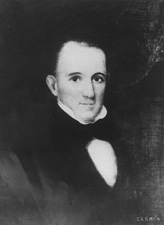Top Qs
Timeline
Chat
Perspective
Arthur P. Bagby
Democratic Governor of Alabama and U.S. Senator from Alabama From Wikipedia, the free encyclopedia
Remove ads
Arthur Pendleton Bagby (1794 – September 21, 1858) was the tenth Governor of the U.S. state of Alabama from 1837 to 1841.[1]
This article includes a list of general references, but it lacks sufficient corresponding inline citations. (May 2020) |
Remove ads
Biography
Born in Louisa County, Virginia, in 1794, he studied law and was admitted to the bar in 1819, practicing in Claiborne, Alabama.
Political career
State House and Senate
He was a member of the Alabama State House of Representatives in 1821, 1822, 1824, and 1834–1836, serving as the youngest-ever speaker in 1822 and 1836, and he served in the Alabama State Senate in 1825.
Panic of 1837 and Governorship
During Bagby's administration, the country was plagued by economic depression due to the Panic of 1837. Bagby introduced measures to assist the state banks, but the state legislature rejected most measures. All the state banks were closed by Bagby's successor, Governor Benjamin Fitzpatrick.[2]
US Senate
A slaveowner, he served in the U.S. Senate from November 21, 1841, when he was elected to fill the vacancy caused by Clement C. Clay's resignation, to June 16, 1848.
During his time in the Senate, he was chairman of the Committee on Territories, the Committee on Claims, and the Committee on Indian Affairs. As a Senator, he supported the annexation of Texas.
Minister of Russia
He then resigned to become Minister to Russia from 1848 to 1849.
Remove ads
Personal life
Bagby's first wife, Emily Steele of Georgia, died in 1825 and is buried in Claiborne, Alabama. Bagby died in 1858 in Mobile, Alabama, and he is interred in Magnolia Cemetery there.
References
Sources
External links
Wikiwand - on
Seamless Wikipedia browsing. On steroids.
Remove ads

